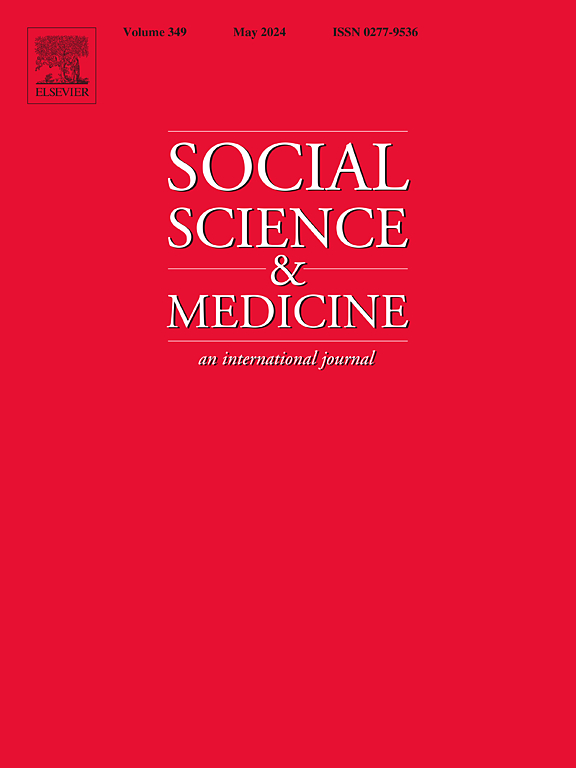分析美国酒精消费的交叉差异。
IF 4.9
2区 医学
Q1 PUBLIC, ENVIRONMENTAL & OCCUPATIONAL HEALTH
引用次数: 0
摘要
酒精是美国可预防死亡的主要原因之一。先前的研究表明,酒精消费和相关死亡率与社会模式有关;但是,还没有研究调查过酒精消费中的交叉差异,即关注社会地位如何重叠和相互作用。在这项研究中,我们采用了一种创新的交叉方法(个体异质性和歧视准确性的多层次分析,MAIHDA)和一项具有全国代表性的大型调查(2000-2018 年全国健康访谈调查)的数据,从性别、种族和民族、年龄和教育水平等维度量化了美国酒精消费的跨类别差异(当前饮酒者的比例和饮酒者的平均消费量)。我们的分析表明,在饮酒率和饮酒者的平均消费量方面存在着明显的交叉差异。在所有年龄段中,受过高等教育的年轻白人男性最有可能成为饮酒者,平均饮酒量也最高;而受教育程度较低的少数种族和民族女性饮酒的可能性最小,饮酒量也最低。值得注意的是,我们发现许多交叉阶层都有明显的交互效应,一些群体的估计消费量要比传统的加法方法高得多。通过识别特定的高消费群体,如年轻的美国印第安人或阿拉斯加原住民(AI/AN)男性、低学历的成年黑人男性以及高学历的老年白人女性,该分析对未来的研究、政策和实践具有重要意义。这是已知的第一个应用 MAIHDA 来解释倾斜结果的方法,强调并解决了关键的方法论问题。本文章由计算机程序翻译,如有差异,请以英文原文为准。
An analysis of intersectional disparities in alcohol consumption in the US
Alcohol is one of the leading causes of preventable deaths in the United States (US). Prior research has demonstrated that alcohol consumption and related mortality are socially patterned; however, no study has investigated intersectional disparities in alcohol consumption, i.e., attending to how social positions overlap and interact. In this study, we used an innovative intersectional approach (Multilevel Analysis of Individual Heterogeneity and Discriminatory Accuracy, MAIHDA) and data from a large nationally representative survey (the National Health Interview Survey, 2000–2018) to quantify inter-categorical disparities in alcohol consumption in the US (proportion of current drinkers, and average consumption amongst drinkers), along dimensions of sex, race and ethnicity, age, and level of education. Our analysis revealed significant intersectional disparities in both the prevalence of drinking and the average consumption by drinkers. Young, highly educated White men were the most likely to be current drinkers and consumed the highest amounts of alcohol on average, whilst racially and ethnically minoritized women with lower education were the least likely to drink and had the lowest levels of alcohol consumption, across all age categories. Notably, we found significant interaction effects for many intersectional strata, with much higher consumption estimated for some groups than traditional additive approaches would suggest. By identifying specific understudied groups with high consumption, such as young American Indian or Alaska Native (AI/AN) men, adult Black men with low education, and older White women with high education, this analysis has important implications for future research, policy, and praxis. This is the first known application of MAIHDA to account for a skewed outcome, highlighting and addressing critical methodological considerations.
求助全文
通过发布文献求助,成功后即可免费获取论文全文。
去求助
来源期刊

Social Science & Medicine
PUBLIC, ENVIRONMENTAL & OCCUPATIONAL HEALTH-
CiteScore
9.10
自引率
5.60%
发文量
762
审稿时长
38 days
期刊介绍:
Social Science & Medicine provides an international and interdisciplinary forum for the dissemination of social science research on health. We publish original research articles (both empirical and theoretical), reviews, position papers and commentaries on health issues, to inform current research, policy and practice in all areas of common interest to social scientists, health practitioners, and policy makers. The journal publishes material relevant to any aspect of health from a wide range of social science disciplines (anthropology, economics, epidemiology, geography, policy, psychology, and sociology), and material relevant to the social sciences from any of the professions concerned with physical and mental health, health care, clinical practice, and health policy and organization. We encourage material which is of general interest to an international readership.
 求助内容:
求助内容: 应助结果提醒方式:
应助结果提醒方式:


